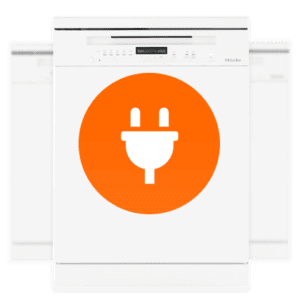How to connect a built-in dishwasher?
Connecting a built-in dishwasher involves the following steps:
Step 1: Disassemble the kitchen cabinet
Make room in the spot where you want to install your dishwasher. Carefully take apart the kitchen cabinet and make sure you are sure your dishwasher will fit. Measure the height, width and depth of both the dishwasher and the niche.
Doesn’t the built-in dishwasher fit into one of your cabinets?
Step 2: Check the connections
You can’t just plug in a dishwasher because you need different connections. An earthed socket and a dishwasher water inlet and outlet are essential.
Please also note that your dishwasher uses so much electricity that it is often necessary to create a new power group and/or outlet.
Step 3: Connect the water supply
If you have a tap, you can connect the hose from your dishwasher straight away. Turn off the faucet, unscrew the siphon connection, connect the water supply to the connection on the siphon. Be sure to remove the rubber stopper from the hose before connecting it, otherwise the water will not be able to drain properly at the connection to the siphon. Loosen the connection to the siphon to check this again. Also, make sure you run the hose straight to the faucet, or you risk a leak.
If you do not have an existing connection nearby, you will first need to make a branch to your dishwasher. To do this, use PVC piping, a supply hose suitable for dishwashers, and pliers to cut the pipes.
Step 4: Connecting Drain
The water from the dishwasher must also be discharged, so connect the dishwasher’s drain hose to the drain.
Make sure to remove the rubber stopper before turning the connection to the siphon. Use the provided hose clamp to seal the end of the drain hose before removing it. Also, don’t put the drain hose too deep into the drain pipe or it won’t pump properly. Most dishwashers come with a hose guide to ensure the drain hose never slips too far inside.
Do you not have an existing drain near your dishwasher? Then you will need to install a separate drain with PVC piping yourself.
Step 5: Connecting the dishwasher to power
Plug the dishwasher into a wall outlet. Make sure that your outlet is at least 30 centimetres away from your separate drain pipe and water inlet.
Step 6: Slide the dishwasher into the recess
Gently slide the dishwasher into the recess. Check that all cables and connections are still in place so the water can flow freely.
When your dishwasher is in place, check that it is level to avoid wearing out the unit too quickly.
Step 7: Run the first wash program
Select a short option for the first wash. Check for water leaks. If the appliance operates without leaks, it is ready to tackle your dirty dishes!
How to connect a freestanding dishwasher?
The advantage of a freestanding dishwasher is that you can plug it in near the appropriate utilities. As long as there is a separate electrical outlet available.
The step-by-step plan for connecting a freestanding dishwasher is therefore also much simpler. You just need to make sure the appliance is level and then the hooking up can begin.
Tighten the connection. You can additionally secure the end of the drain hose with a clamp.
Check that all the cables are in place and that there is no kink that could cause leakage. Test the first program and if that goes well you are ready to go!
Who can connect a dishwasher?
Do you find connecting a dishwasher a bit too complicated even with the step-by-step plan?
Sometimes the company you purchased from can hook up the dishwasher, but you can also use a plumber.
This is especially helpful if you don’t have the right connections nearby. A professional will make sure that all the pipes are moved and that you get a suitable outlet nearby.

